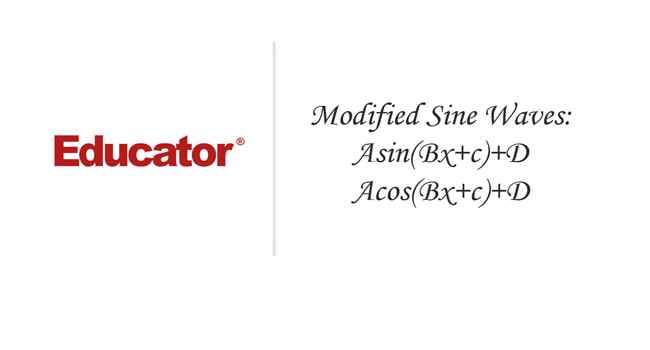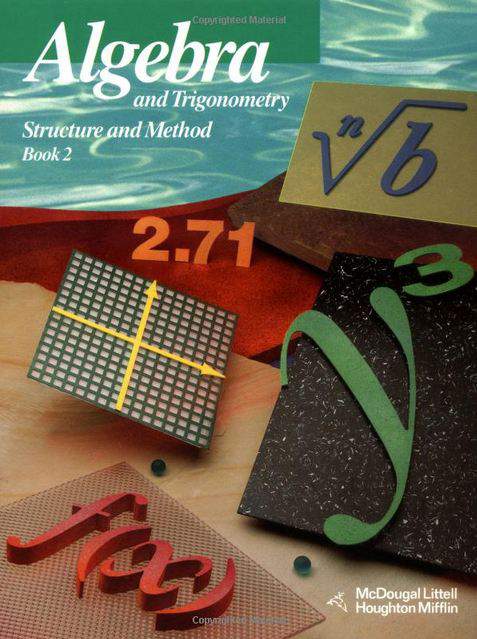Connecting...

This is a quick preview of the lesson. For full access, please Log In or Sign up.
For more information, please see full course syllabus of Trigonometry
For more information, please see full course syllabus of Trigonometry
Trigonometry Modified Sine Waves: Asin(Bx+C)+D and Acos(Bx+C)+D
Lecture Description
In this video you will learn about modified sine waves. Instead of using sin(x), you'll start using sin(2x), 5sin(3x),12cos(x+4) and so on. You'll learn what each of these new numbers in the new function represent, how they affect its graph (how they move it around), and how to actually graph the new functions. A very important characteristic of sine and cosine functions is that they are periodic. Their graph is formed by repeated patterns. Also, the graph of the sine function has a specific height. Using all these properties, you'll see the amplitude, the period, the domain and the range, and how to apply transformations on the base function sin(x).
Bookmark & Share
Embed
Share this knowledge with your friends!
Copy & Paste this embed code into your website’s HTML
Please ensure that your website editor is in text mode when you paste the code.(In Wordpress, the mode button is on the top right corner.)
×
Since this lesson is not free, only the preview will appear on your website.
- - Allow users to view the embedded video in full-size.
Next Lecture
Previous Lecture










































 Answer Engine
Answer Engine





















2 answers
Last reply by: Jimmy Luo
Thu Jul 1, 2021 7:51 PM
Post by Jimmy Luo on June 29, 2021
Is there a way to save your progress as in when you come back to a video, it will continue from where you left off the last time you watched it?
2 answers
Last reply by: Ann Gao
Tue Jul 14, 2020 4:25 PM
Post by Ann Gao on July 11, 2020
Hi professor, my teacher gave me this problem and I can't quite figure it out. It says to watch this video https://players.brightcove.net/1126213333001/default_default/index.html?videoId=5556623829001
"Assume the camera is placed 6 feet from the center of the merry-go-round and the diameter of the merry-go-round is 6 feet. Build a trigonometric function that models the distance (feet) of the rider from the camera as a function of time (seconds). " Would you help me get started on this?
1 answer
Fri May 8, 2020 9:54 AM
Post by Kevin Liang on May 7, 2020
Hello professor,
I have a question regarding the phase shift. I don't get why when the phase shift is positive, the origin moves to the right and vice versa. Shouldn't it be the other way around? Thanks for the amazing lectures.
1 answer
Wed Mar 25, 2020 11:40 AM
Post by Matthew Zhang on March 24, 2020
Hello Professor,
For the phase shift of the sine function, is it possible to move the function to the left into the 2nd quadrant? Or will it only be possible to move it C/B units to the right?
Thank you for the very helpful lectures!
1 answer
Last reply by: Epcvan
Fri Mar 20, 2020 12:15 AM
Post by danielfangzhu on March 19, 2020
Isn't B(x + C/B) = B[x-(-C/B)], not B[x - C/B]? (for the phase shift)?
1 answer
Wed Mar 18, 2015 8:10 PM
Post by Napolean Richard on March 16, 2015
Dear sir,
As the amplitude can the value of| A|.SO if there are two possible answers in the Example 3:2sin(pi/2*x-pi/4)+1 and -2sin(pi/2*x-pi/4)+1?and so does the graph?
1 answer
Sun Jan 4, 2015 7:35 PM
Post by Rasheed Abdullah on December 31, 2014
Thank you for the wonderful lecture. However I noticed that, because the amplitude is always the absolute value of "A," the number there can be either negative or positive and still form the same graph. Is this true for all sine and cosine waves or is there a change to the graph when a negative number is used?
Thank you,
Rasheed A.
1 answer
Mon Nov 3, 2014 9:16 PM
Post by Carroll Fields on November 1, 2014
I have another question. Why on the period portion of the question "B", are you writing for example, in Extra Example II: 2/3x, I thought it would be 2/3pi.
Thanks a lot for the lecture, it helped me very much in learning this concept.
Rusty
1 answer
Mon Nov 3, 2014 9:15 PM
Post by Carroll Fields on November 1, 2014
Can you please explain again the math behind the vertical shift: -C/B.
How you factored out B?
Thank You,
Rusty
1 answer
Tue Aug 5, 2014 3:05 PM
Post by Jason Wilson on July 21, 2014
My previous question is referencing example one time around 13:50-14:50ish thnks
1 answer
Tue Aug 5, 2014 3:06 PM
Post by Jason Wilson on July 21, 2014
a couple of Quick questions. The phase shift of course takes on the transformation properties. - goes right, positive goes left, am I correct on that thought?
If so the formula for phase shift contains -c/b. If both c and b are positive in the problem, and then you plug those positive values into the formula, they then turn negative because of the formula, then why isnt the
phase being shifted right , hence the negative sign in the formula?
1 answer
Thu Apr 3, 2014 1:52 PM
Post by Christopher Lee on March 29, 2014
In Example 3, couldn't A = -2, since the amplitude is defined as |A|, abs(A)? abs(A)=2 means that A can equal 2 or -2, right?
1 answer
Sat Feb 1, 2014 12:19 AM
Post by Mae Linda Vidal on January 22, 2014
Finally I understand how to do this! Thank you so much! Does it matter which one to use (sine or cos) if given a graph and needing to find the equation for it?
1 answer
Fri Nov 22, 2013 5:44 PM
Post by Carolyn Lesperance on November 21, 2013
If you are given the graph of a sine function and need to write an equation for it, how would you determine the horizontal stretch/compression?
5 answers
Last reply by: Carroll Fields
Wed Feb 26, 2014 3:10 PM
Post by Suhani Pant on August 2, 2013
In Extra Example II, can you explain the math involved in stretching out the period to 3pi?
2 answers
Last reply by: Jason Wilson
Mon Jul 21, 2014 6:29 AM
Post by Monis Mirza on May 17, 2013
Hi,
For the phase shift, how would we know if the graph moves to the left?
1 answer
Wed May 22, 2013 3:14 PM
Post by Jonathan Traynor on May 17, 2013
May I commend and congratulate you on doing such an incredible job on explaining what I previously found such a difficult concept. In example 2 we had an amplitude of -2. Could you please explain why a minus amplitude causes the curve to flip. Thanks again and I am finally understanding and enjoying Trig. You are a great teacher!!!!!
1 answer
Sun Apr 28, 2013 10:24 AM
Post by varsha sharma on April 27, 2013
On asine(bx+c)+d
Doesn't the wave shift left since phase shift is negative c/b ?
1 answer
Tue Apr 16, 2013 8:25 PM
Post by Dave Seale on April 13, 2013
on EX2 -2sin(2x-pi/3) the phase shift graphed in red pen shows the left side of the function intersecting the y-axis at 2 units instead of crossing the y-axis at 1 unit which is where the function would lie after the phase shift and remain since the vertical shift is zero. Honest illustration error, but I didn't want anyone to be confused!
1 answer
Mon Oct 1, 2012 5:10 PM
Post by Jialan Wang on September 28, 2012
you should have some practice after every lecture
otherwise, you can't practice what you have learned in the lecture
1 answer
Fri Aug 31, 2012 5:32 PM
Post by Timothy Ellis on July 27, 2012
why bother going throught the whole process of reversing the equation when you just end up graphing what was given in the example to begin with?
1 answer
Fri Aug 31, 2012 5:36 PM
Post by Timothy Ellis on July 27, 2012
having a hard time figuring out how the phase shift becomes -pi/4. I can't seem to see the algebra could you break it down for me please?
1 answer
Fri Aug 31, 2012 5:45 PM
Post by Safreeca Logan on June 13, 2012
your a great instructor. I've learned more fro you in a couple days thsn this whole semester
1 answer
Fri May 18, 2012 1:15 AM
Post by Michael Feldman on April 3, 2012
the quick notes don't match the video
1 answer
Tue Apr 16, 2013 8:16 PM
Post by dorian pedraja on February 27, 2012
at the 13 minute mark, why is the period (pi/2) = 3cos(4x)? that makes no sense to me
1 answer
Tue Apr 16, 2013 8:11 PM
Post by Irene Holly on January 18, 2012
Exsmple 3 should have been pi/4 not pi/2 if i remember correctly... Under Amp and period of a sin wave?
5 answers
Tue Apr 16, 2013 8:04 PM
Post by Robert Haycock on May 14, 2011
H
1 answer
Tue Apr 16, 2013 8:03 PM
Post by Mike Jones on March 29, 2011
question at 7:00 minutes - should that be "B(X + C/B)" becomes "B[X-(-C/B)]", NOT becomes "B[X-(C/B)" ?